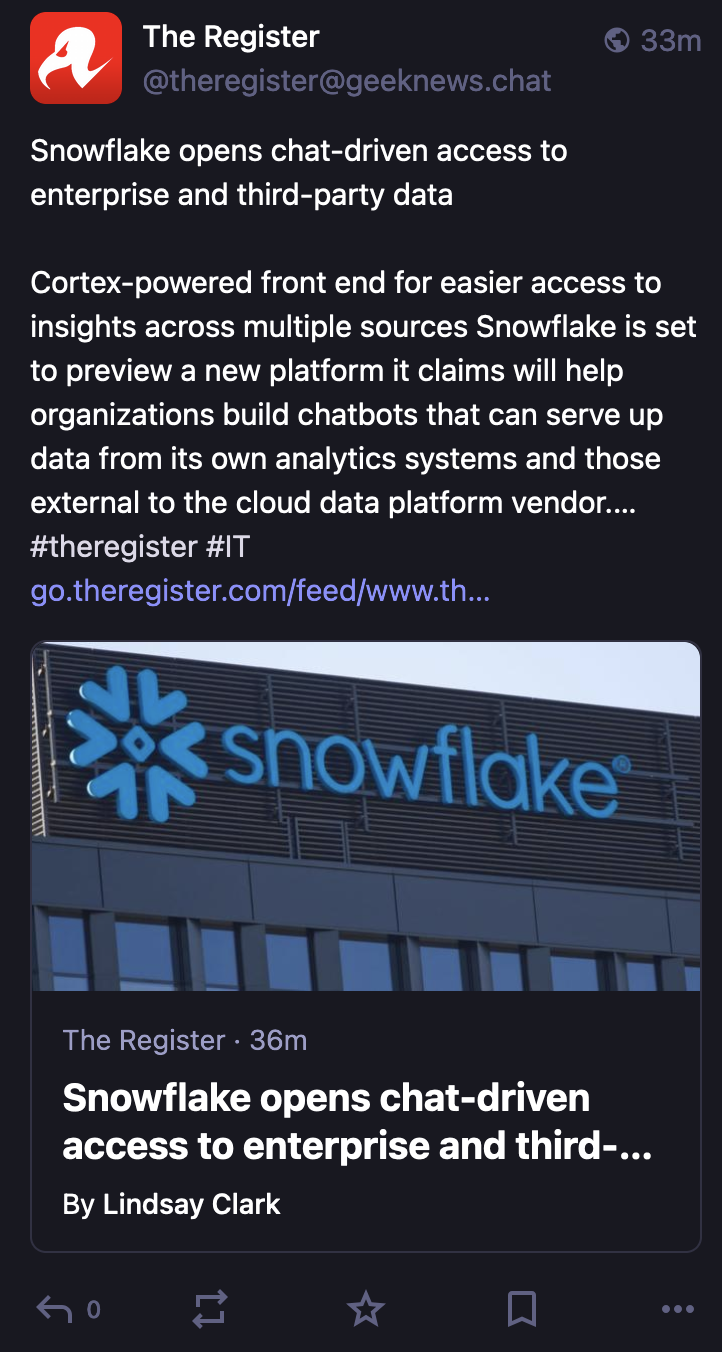Posts
2424Following
583Followers
1293Heretek of Silent Signal
Julian Stecklina
blitz@infosec.exchangeWow Intel SGX and Sub-Page Protection exploded at the same time yesterday. The latter is so broken Intel removes it from all future processors. 👀
buherator
buheratorhttps://blog.cloudflare.com/amazon-2bn-ipv4-tax-how-avoid-paying/
#CunninghamsLaw
Advanced Fuzzing League
aflplusplus@infosec.exchangebuherator
buheratorhttps://therecord.media/nist-vulnerability-backlog-cleared-cisa
buherator
buheratorhttps://medium.com/@renwa/arc-browser-uxss-local-file-read-arbitrary-file-creation-and-path-traversal-to-rce-b439f2a299d1?source=rss-3f8ae70e3957------2
MWL Book Quote Bot
quotebot@io.mwl.ioRemove /dev/null from a host and a surprising number of programs crash and burn. Experienced sysadmins understand that most software requires an uninterruptible supply of nothing.
Caitlin Condon
catc0n@infosec.exchangeFull Rapid7 analysis and #exploit PoC (with root shell!) for #FortiManager #CVE202447575 via @stephenfewer 🐚 Not a simple project, as it turned out :) https://attackerkb.com/topics/OFBGprmpIE/cve-2024-47575/rapid7-analysis
Ken Shirriff
kenshirriff@oldbytes.spaceThe Pentium processor had a minor error in the division algorithm. This error cost Intel $475 million to replace the faulty chips. I've tracked down the FDIV error to this circuit on the die:
Will Dormann
wdormann@infosec.exchangeMe to Matomo:
Your installation instructions guarantee that Windows will be vulnerable to LPE. You should probably fix that.
Matomo:
"Unfortunately we do not consider this as a security issue, because it's actually fully unrelated to Matomo itself."
Great job, folks!
Clownstrike @ 358...
Cyber incidents appear to have no long term impact ;-)
The Shadowserver Foundation
shadowserver@infosec.exchangeWe have observed D-Link NAS CVE-2024-10914 /cgi-bin/account_mgr.cgi command injection exploitation attempts starting Nov 12th. This vuln affects EOL/EOS devices, which should be removed from the Internet: https://supportannouncement.us.dlink.com/security/publication.aspx?name=SAP10413
We see ~1100 exposed.
We share IP data on exposed D-Link NAS instances for your network/constituency in our Device ID reports (vendor D-Link, type: nas): https://shadowserver.org/what-we-do/network-reporting/device-identification-report/
D-Link NAS exposure tracker https://dashboard.shadowserver.org/statistics/iot-devices/time-series/?date_range=7&vendor=d-link&type=nas&model=sharecenter&dataset=count&limit=1000&group_by=geo&style=stacked
Not a Goat 🦝
screaminggoat@infosec.exchangeHappy #PatchTuesday on a Wednesday from Palo Alto Networks:
- PAN-SA-2024-0016 Chromium: Monthly Vulnerability Updates
- CVE-2024-5920 (CVSSv4: 4.6 medium) PAN-OS: Stored Cross-Site Scripting (XSS) Vulnerability in PAN-OS Enables Impersonation of a Legitimate Administrator
- CVE-2024-2550 (CVSSv4: 8.7 high) PAN-OS: Firewall Denial of Service (DoS) in GlobalProtect Gateway Using a Specially Crafted Packet
- CVE-2024-2551 (CVSSv4: 8.7 high) PAN-OS: Firewall Denial of Service (DoS) in GlobalProtect Gateway Using a Specially Crafted Packet
- CVE-2024-2552 (CVSSv4: 6.8 medium) PAN-OS: Arbitrary File Delete Vulnerability in the Command Line Interface (CLI)
- CVE-2024-5917 (CVSSv4: 6.3 medium) PAN-OS: Server-Side Request Forgery in WildFire
- CVE-2024-5918 (CVSSv4: 5.3 medium) PAN-OS: Improper Certificate Validation Enables Impersonation of a Legitimate GlobalProtect User
- CVE-2024-5919 (CVSSv4: 5.1 medium) PAN-OS: Authenticated XML External Entities (XXE) Injection Vulnerability
- CVE-2024-9472 (CVSSv4: 8.7 high) PAN-OS: Firewall Denial of Service (DoS) Using Specially Crafted Traffic
"Palo Alto Networks is not aware of any malicious exploitation of this issue." RE:CVE-2024-9472: "However, customers have reported encountering this issue during normal operations."
buherator
buheratorhttps://seclists.org/oss-sec/2024/q4/80
Samuel Groß
saelo@chaos.socialAnother big step towards becoming a security boundary: today we’re expanding the VRP for the V8 Sandbox
* No longer limited to d8
* Rewards for controlled writes are increased to $20k
* Any memory corruption outside the sandbox is now in scope
See https://bughunters.google.com/about/rules/chrome-friends/5745167867576320/chrome-vulnerability-reward-program-rules#v8-sandbox-bypass-rewards for more details.
Happy hacking!
Chris Wysopal @ Shmoocon
Weld@infosec.exchangeThrilled to share my BlueHat keynote is now live! 🎤
"A Clash of Cultures Comes Together to Change Software" dives into how early hacker groups like the L0pht began collaborating with tech companies, reshaping software security.
Watch here: https://www.youtube.com/watch?v=w6SAqT4ZQik
🦜 @b1ack0wl.bsky.social on Bluesky
bsky.app.profile.b1ack0wl.bsky.social@rss-parrot.netbsky.app/profile/b1ack0wl.bsky.social/post/3latq4vftsk2a
Heads up: that viral "backdoor attempt" against multiple GitHub repos is a smear campaign. The lame code that was submitted is also a part of it since it's there to paint a picture of someone with very little offensive skills. Don't fall for the bait
Not a Goat 🦝
screaminggoat@infosec.exchangeGitLab security advisory: GitLab Patch Release: 17.5.2, 17.4.4, 17.3.7
- CVE-2024-9693 (8.5 high) Unauthorized access to Kubernetes cluster agent
- CVE-2024-7404 (6.8 medium) Device OAuth flow allows for cross window forgery
- requested CVE ID not yet available (6.5 medium) Denial of Service by importing malicious crafted FogBugz import payload
- CVE-2024-8648 (6.1 medium) Stored XSS through javascript URL in Analytics dashboards
- CVE-2024-8180 (5.4 medium) HTML injection in vulnerability Code flow could lead to XSS on self hosted instances
- CVE-2024-10240 (5.3 medium) Information disclosure through an API endpoint
No mention of exploitation.
#GitLab #PatchTuesday #CVE #vulnerability #infosec #cybersecurity
Hector Martin
marcan@social.treehouse.systemsA lot of people think Apple Silicon Macs can boot from external storage, and Apple themselves go to great lengths to pretend they can.
However, the iBoot bootloader does not have USB or Thunderbolt drivers at all, and absolutely cannot boot from external storage in any way, shape, or form.
But they're cheating.
When you "select" an external volume to "boot" from, whether from macOS or recoveryOS or the Boot Picker (which is just recoveryOS, which is just macOS), the fully booted OS with full access to external storage will copy the bootloader, firmware, and OS kernel to internal storage, then configure the machine to boot off of THAT. Then the bootloader is still just booting off of internal storage.
You can see this if you set up "external" boot, then try to power on the machine without the disk connected. The progress bar will appear below the Apple logo, and that progress bar is drawn by the macOS kernel, which proves macOS is already running, even though supposedly you removed the disk it's booting from. It only times out and fails a few seconds later when it can't find the external disk to mount the root filesystem from.
BTW, the only blocker for supporting the same exact mechanism for USB boot in Asahi Linux is that m1n1 does not have USB drivers either, which it needs to chain off stage 2 from USB. So if anyone wants to help out and write a bare-metal xHCI USB stack with enough support for hubs and mass storage devices in Rust... ;-)







